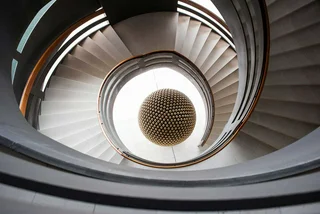Prague's culture scene has had to get creative, with venues closed. But some events are still taking place under modified conditions. The Cirkopolis festival puts performers behind glass, and the National Theater is presenting a new English-friendly drama that lets people participate from home. Several art galleries have made outdoor or online exhibitions.
The eighth edition of the Cirkopolis festival is underway and runs until Feb. 12 behind one of the glass windows at the cubicles on Náplavka, Prague’s waterfront at Rašínovo nábřeží. Performances are always between 6 p.m. and 8 p.m.
PARTNER ARTICLE
The performances behind the giant glass window of the cubicle used by (A)void Gallery will take place in compliance with all government regulations.
“It was not easy for us to give up the traditional date of the festival and the planned foreign program, but we nevertheless took the current situation as a challenge,” Šárka Maršíková, artistic director of Cirkopolis, said in a press release.
“We felt that the gallery space on the embankment explicitly encourages some action, and I believe that for spectators who miss live art, it will be a magical experience,” she added.

The festival will offer short performances that border between art installation, happening, and circus. “I think it will be a bit of a voyeur experience for the audience if we allow them to peek into four completely unique rooms,” she added.
The goal is to offer the viewer live art in these difficult times and to encourage performers to take a slightly different way of creating. “This time they will become such a lively art installation. Since we don't want to endanger anyone, the whole festival team and artists will be tested,” Maršíková said.
Safety for the artists and viewers is foremost. “We invite spectators and ask them to wear respirators. We will of course also supervise safe distancing. The performers are behind the glass and the spectators can watch them through the giant glass from the outdoor area of the embankment,” she added.
While the performances are free, people can support them by buying a donation ticket for CZK 100 to CZK 500 from the Goout network. Each of the live performances lasts 15 minutes and is stage several times
On Feb 10, Lukáš Karásek will stage “Living Room in a Cubicle” at 6 p.m, 7 p.m., and 8 p.m. In the performance, the furniture will come to life but cannot leave the area where it has been installed.
The next day, Filip Zahradnický puts on a juggling show called “Collection of Sceptical Pleasures.” Themes in the show include the desire to own things and increase our wealth, while constantly searching for what wealth actually is. Shows will be at at 6 p.m, 7 p.m., and 8 p.m.

The final day of the shows sees Cécile Da Costa perfroming “Roselyne,” about a woman who wants to be invisible in her flat. Shows will be at 6 p.m., 6:30 p.m., 7 p.m., and 7:30 p.m.
Performance details can be found on the Cirkopolis website and on Facebook.
The National Theater is presenting “Distant Thoughts.” Participants have to register online and fill out a questionnaire. The performance is a conversation for two people who do not know each other. They follow a script where some text is predetermined but most of the time you are left a lot of room for your own words and thoughts.
“The script gives you something to hold onto, but also challenges you. This is an unusual encounter between strangers,” the National Theater said.
The next performance is Feb. 10 with another taking place Feb. 18 at 9 p.m. The experience can be tailored to English speakers. Details can be found on the National Theater website.
The Pragovka Gallery is presenting interactive exhibitions over their website, with more information on Facebook. Viewers can virtually wander the space of the former vehicle factory to see several installations.
The French Institute in Prague has an interactive light show called Everyone Together (Všichni spolu) on its facade nightly until Feb. 26. People can send massages to be displayed by using a QR code on the poster in front of the building or by going to the French Institute’s website. More details are on the French Institute’s Facebook page.
Frýdlantská gallery, in Prague’s Ďáblice neighborhood the former cooperative store Včela, plans six exhibitions in the store windows. The exhibition Out of Season (Mimo sezónu) by photographer Štěpán Jílek can be seen there until the end of March. All the planned exhibitions are joined by the theme of empty space. The gallery is located at Frýdlantská 26, near the Sídliště Ďáblice bus stop.
Czech Design Week in cooperation with Art District Vyšehrad has a series of glass display cases in front of the Congress Center, next to the Vyšehrad metro stop. They will be in place until April.
The Art Behind the Line exhibition of art in four Prague metro stations — Florenc, Můstek, Karlovo náměstí, and Náměstí Republiky — has been extended to March 31. An outdoor gallery has also opened up at the Vltavska metro stop, with exhibitions that will change every three months.
While many people don’t realize it, the park Bezručovy sady in Vršovice, near the Krymská tram stop, is also Galerie ProLuka. Currently there is a billboard with an image of the earth and the text “limited edition.”
Fasáda (Facade) gallery on the front of a damaged building on Divadelní Street has art in the bricked-up windows. The exhibition changers twice a year.
The Prague City Gallery (GMPH) has posted a map of all of the city-owned public art, which includes most publicly visible statues. People can make their own self-guided tours.
And there is always the Lennon Wall to visit.












 Reading time: 4 minutes
Reading time: 4 minutes 
























